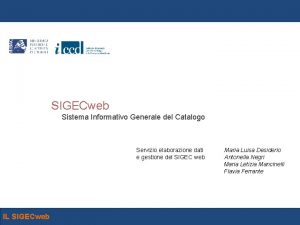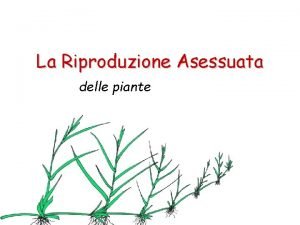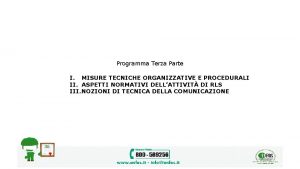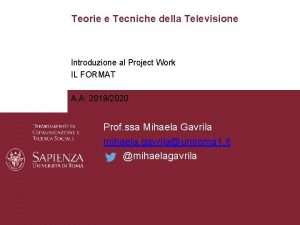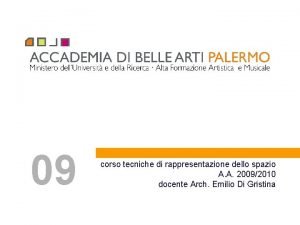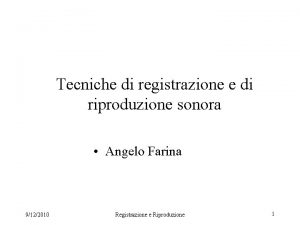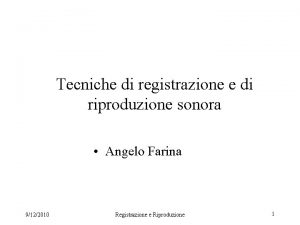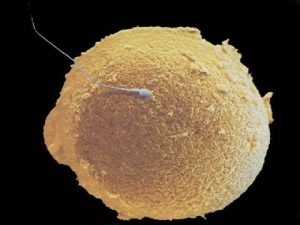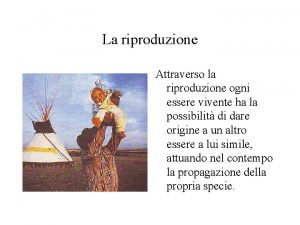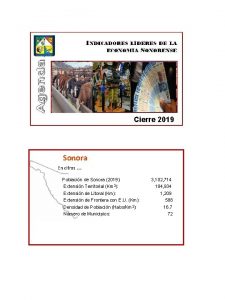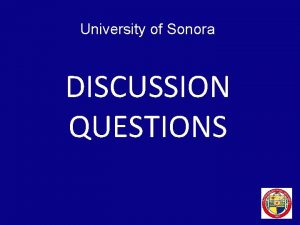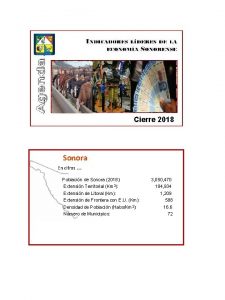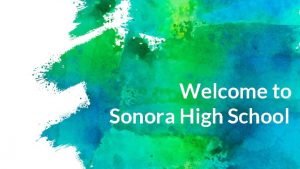Tecniche di registrazione e di riproduzione sonora Angelo
























- Slides: 24

Tecniche di registrazione e di riproduzione sonora • Angelo Farina 9/12/2010 Registrazione e Riproduzione 1

Physical nature of sound Origin of Sound: Thermofluidodynamic phenomenon: Particle velocity and variable density of medium (air) Human body can detect sound (p and v) with: ears, but also skin, chest, stomach The trasducers should detect the same quantities 9/12/2010 Registrazione e Riproduzione 2

Transducers: microphones From acoustic pressure and particle velocity to physical (electrical) quantities Output signal: voltage (Volts), current (Amperes) or charge (Coulombs) Pressure microphones (related with acoustic pressure) Velocity microphones (related with particle velocity) Hybrid microphones (a proper combination of both quantities) From omnidirectional (100 p and 0 v) to figure of eight (0 p and 100 v) 9/12/2010 Registrazione e Riproduzione 3

Microphone directivity patterns Omnidirectional (100, 0) Subcardioid (75, 25) Hypercardioid (25, 75) 9/12/2010 Cardioid (50, 50) Figure-of-Eight (0, 100) Registrazione e Riproduzione 4

Microphones Variable pattern microphone: Neumann U 89 i variable-pattern microphone 9/12/2010 Registrazione e Riproduzione 5

Cables The weak microphone signal (few m. V/Pa) has to be amplified and transmitted by means of cables Signal contamination can occur inside the cable, if not properly shielded (balanced) with two oppositepolarity signals Balanced audio cables with XLR connectors (3 pins) 9/12/2010 Registrazione e Riproduzione 6

Preamplifiers They should simply amplify the signals, but often they also process the signals: • linearly (band pass frequencies), for phantom power supply to mics • non-linearly (compression, harmonic distortion) it should be avoided during room acoustics measurements. 2 -channels tube microphone preamplifier 9/12/2010 Registrazione e Riproduzione 7

ADC (Analog to Digital Converter) Conceptually a black box connecting with two wires: • Analog input (sound signal) • Digital output (serial digital interface) Two different types of ADCs: 1. PCM converters (Pulse Code Modulation – CD, DAT, DVD) 2. Bitstream converters (DSD, Direct Stream Digital, also called single-bit, employed in SACD). 9/12/2010 Registrazione e Riproduzione 8

ADC (Analog to Digital Converter) 2 PCM Converters A master clock defines with high precision the instants at which the analog signal has to be “sampled” (Shannon theorem) Applications Resolutions CDs 44100 Hz 48000 Hz 96000 Hz 192000 Hz DAT, DVD Video DVD audio HD rec. Special soundcards 9/12/2010 Registrazione e Riproduzione 9

ADC (Analog to Digital Converter) 3 Low-pass filtering must be applied before entering the ADC, otherwise the signal will be aliased Example: pure tone of 35 k. Hz Sample rate 48 k. Hz, k. Hz Nyquist freq. 24 k. Hz, difference = 11 After digital conversion will be 13 k. Hz (i. e. 24 -11 k. Hz) Solution: low-pass antialiasing filters, oversampling 9/12/2010 Registrazione e Riproduzione 10

ADC (Analog to Digital Converter) 4 Also vertical axis (amplitude) is discretized. Typical resolutions: 16 bits; 20 bits; (24 bits) Example: maximum voltage +5 V Discretization with 16 bit (32767 steps) means 90 d. B Discretization with 20 bit (524272 steps) means 114 d. B High-end, 2 -channels ADC unit (24 bits, 192 k. Hz, Firewire interface) 9/12/2010 Registrazione e Riproduzione 11

ADC (Analog to Digital Converter) 5 Bitstream Converters • The idea arises from oversampling: increasing sample frequency it would be possible to increase amplitude resolution (bits) • Sample rate: 2. 88 MHz and 1 bit resolution: dividing to 2 for 6 time is equivalent to CD audio sample rate, but only with 7 bits! • In order to enhance high freq. resolution, a proper noise shaping of high order is required, suitable for static (non transient) signals. • Below 88 Hz the Bitstream converters outperform PCM conv. 9/12/2010 Registrazione e Riproduzione 12

ADC (Analog to Digital Converter) 6 Bitstream Converters • The Bitstream converters are widely employed with SACD system (Super Audio CD), co-developed by Sony and Philips. • However they are much more expensive that 24 bit 96 k. Hz PCM a low-cost multichannel USB-2 soundcard, equipped with 2 microphone preamps 9/12/2010 Registrazione e Riproduzione 13

Digital Signal Processing Waveform editors sampled waveform displayed as amplitude vs time (time domain) 9/12/2010 Registrazione e Riproduzione 14

Recording/playback methods • • Mono followed by amplitude panning (stereo or surround) Stereo (ORTF on 2 standard loudspeakers at +/- 30°) Discrete ITU 5. 1 (from different 5 -mikes layouts) Full 3 D Ambisonics 1 st order (decoding the B-format signal) 2 D Ambisonics 3 rd order (from Mark Poletti’s circular array microphone) Wave Field Synthesis (from the circular array of Soundfield microphones) Hybrid methods (Ambiophonics) 9/12/2010 Registrazione e Riproduzione 15

Metodo tradizionale (registrazioni mono “panned”) 5 ch. 1 ch. 5 ch. M I X 5 ch. Surround panner • Ciascuna traccia mono registrata rappresenta una sorgente in una diversa posizione, che viene posizionata mediante una appropriata legge di “panning” multicanale 9/12/2010 Registrazione e Riproduzione 16

Leggi di “panning” • Si è visto sin dagli albori che non conviene posizionare le tracce mono sui singoli canali del surround in modo discreto, ma che conviene utilizzare appropriate leggi di “panning” in modo da alimentare sempre piu’ di un altoparlante per volta Panning basato sulla teoria di Peter Craven - il segnale viene inviato sempre a tutti 5 gli altoparlanti, con opportuni guadagni 17 Registrazione e Riproduzione “Pairwise Panning” a potenza costante - il segnale viene inviato a due altoparlanti per volta 9/12/2010

Leggi di “panning” • Un modo alternativo per visualizzare le leggi di panning consiste nell’ipotizzare l’esistenza di 5 microfoni virtuali con opportuni “pattern” di direttività “Pairwise Panning” 9/12/2010 Panning di Peter Craven Registrazione e Riproduzione 18

ORTF Stereo 60° 2 Microphones 2 Loudspeakers Playback occurs over a pair of loudspeakers, in the standard configuration at angles of +/- 30°, each being fed by the signal of the corresponding microphone 9/12/2010 Registrazione e Riproduzione 19

Binaural (Stereo Dipole) Original 2 -channels recording of the signals coming from N sources d. Nr N … 3 d. Nl xr Cross-talk canceller d 2 r 2 20° xl d 2 l 1 d 1 r d 1 l Reproduction occurs over 2 loudspeakers angled at +/- 10°, being fed through a “cross-talk cancellation” digital filtering system 9/12/2010 Registrazione e Riproduzione 20

Binaural (Stereo Dipole#2) 9/12/2010 Registrazione e Riproduzione 21

Binaural (Stereo Dipole#3) hll hrl fll frl hlr hrr flr frr 9/12/2010 Registrazione e Riproduzione 22

Binaural (Dual Stereo Dipole) advantages: Scheme n n n 3 D sound reproduction Rotating of the head The cross-talk filters could equalise also the loudspeakers disadvantages: n Subwoofer 9/12/2010 n Registrazione e Riproduzione Low frequencies Coloration outside the “sweet spot” 23

Binaural (Dual Stereo Dipole#2) Frontal Rear Quested 2108 monitors Quested F 11 P monitors 9/12/2010 Registrazione e Riproduzione 24
 Avisnet registrazione
Avisnet registrazione Etwinning registrazione
Etwinning registrazione Art 2222
Art 2222 Sigec web
Sigec web Silavsicilia.it registrazione
Silavsicilia.it registrazione Estremi del contratto di locazione
Estremi del contratto di locazione Esiti avversi della riproduzione
Esiti avversi della riproduzione Il fiore e la riproduzione
Il fiore e la riproduzione Vietata la riproduzione anche parziale
Vietata la riproduzione anche parziale Apparato riproduttore femminile
Apparato riproduttore femminile Riproduzione dei rettili
Riproduzione dei rettili La riproduzione
La riproduzione Coniugazione riproduzione
Coniugazione riproduzione Descrizione del cane scuola primaria
Descrizione del cane scuola primaria Riproduzione piante
Riproduzione piante Talea banano
Talea banano Metodi di separazione dei miscugli
Metodi di separazione dei miscugli Tecniche pittoriche moderne
Tecniche pittoriche moderne I cartelli di sicurezza di colore rosso cosa indicano anfos
I cartelli di sicurezza di colore rosso cosa indicano anfos Teorie e tecniche della televisione
Teorie e tecniche della televisione Italo svevo poetica
Italo svevo poetica Tecniche di socializzazione
Tecniche di socializzazione Tecniche di rappresentazione dello spazio
Tecniche di rappresentazione dello spazio Comunicazione organizzativa aziendale
Comunicazione organizzativa aziendale La lupa tecniche narrative
La lupa tecniche narrative



